
Impression of lobed Proteaceae leaf (SAM P59649) from the Stuart Creek fluvial silcrete, South Australia.
With so much of Earth's long history recorded in the geology, it’s quite astonishing that there are grown adults who still believe Earth is about 10,000 years old and was created out of noting, along with everything on it, in 6 days, with a few magic words, and that the science which shows otherwise is false or even forged.
It's even more astonishing that many of those people will live in technologically advanced societies that take products of science such as modern medicines, air transport, electricity, computers, radio and telephone communications and satellite navigation systems for granted and will never have any doubt about the truth of the science that created them.
Yet here we have yet more evidence that there were plants growing and leaving fossilised remains, 30 million years before creationists believe 'Creation Week' happened. And all they will have by the way of rationalising the facts with their evidence free-superstition is to lie about the science and claim the scientists used a flawed dating method that somehow managed to make 10,000 years look like 30 million years, or they lied about their results for some nefarious reason as part of a multi-million person conspiracy about which no-one ever breaks ranks and blows the whistle, even though they would gain instant fame and fortune if ever they did so.
And the same creationists who will tell that lie are the same people who hang on every word of a small handful of pseudo scientists who have taken an oath to always reach a required conclusion in their work, regardless of what the facts really reveal, as a condition of their employment.
How and where these fossils were found and dated, and the geological processes of silicification that preserved them, is the subject of a recent paper in the journal Gondwana Research. Andrew Rozefelds, Adjunct Assoc Professor in Central Queensland University and Principal Curator Geosciences Queensland Museum, CQ University Australia, lead author of the paper in Gondwana Research has also written about the research in an article in The Conversation, reprinted here under a Creative Commons license, reformatted for stylistic consistency:

A botanical Pompeii: we found spectacular Australian plant fossils from 30 million years ago
Details of a silicified fern fossil.
Geoff Thompson/Queensland Museum
Andrew Rozefelds, CQUniversity Australia
The Australian continent is now geologically stable. But volcanic rocks, lava flows and a contemporary landscape dotted with extinct volcanoes show this wasn’t always the case.
Between 40 and 20 million years ago – during the Eocene to Miocene epochs – there was widespread volcano activity across eastern Australia. In places such as western Victoria and the Atherton Tablelands in Queensland, it was even more recent.
Erupting volcanoes can have devastating consequences for human settlements, as we know from Pompeii in Italy, which was buried by ash when Mount Vesuvius erupted in 79 CE. But ash falls and lava flows can also entomb entire forests, or at least many of the plants within them.
Our studies of these rare and unique plant time capsules are revealing exquisitely preserved fossil floras and new insights into Australia’s botanical history. This new work is published in the journal Gondwana Research.
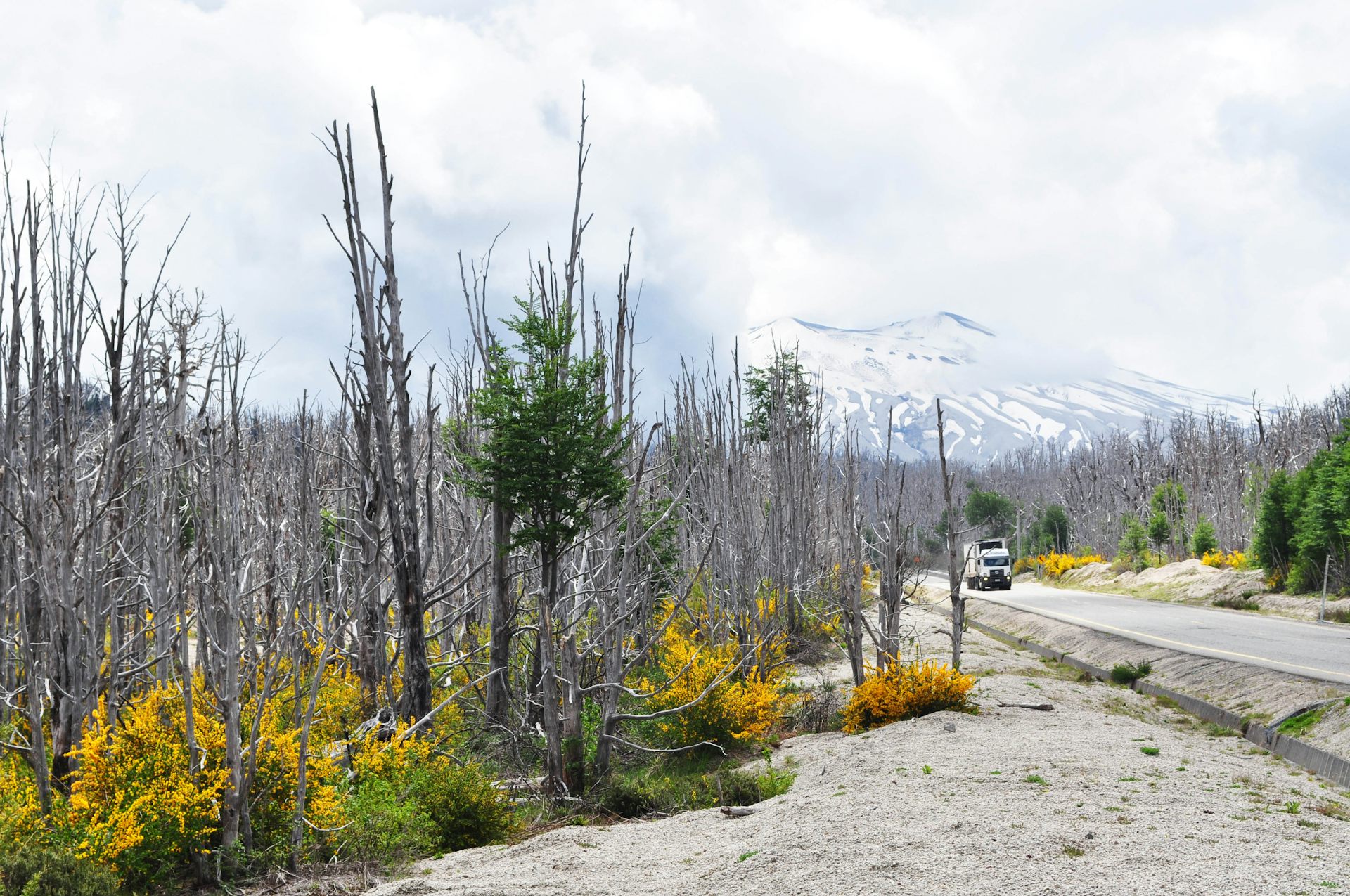
This is what volcanoes can do to landscapes – super-heated gasses from the 2011–12 eruption of Puyehue-Cordon Caulle Volcano in Argentina killed the forest. After ten years, the forest has started to regrow.
Andrew Rozefelds
The most common volcanic rocks are basalts. The rich red soils derived from them are among the most fertile in Australia.
But the rocks in which fossils occur are buried under basalts or other volcanic rock, and are called silcretes – the name indicates their origins are from silica-rich groundwaters. Silica is the major constituent of sand, and familiar to most of us as quartz.
What makes the silcrete plant fossils so fascinating is the superfine preservation of plant material. This includes fine roots and root nodules, uncurling fern fronds and their underground stems, the soft outer bark of wood, feeding traces and frass (powdery droppings) of insects, and even the delicate tissues and anatomy of fruits and seeds.
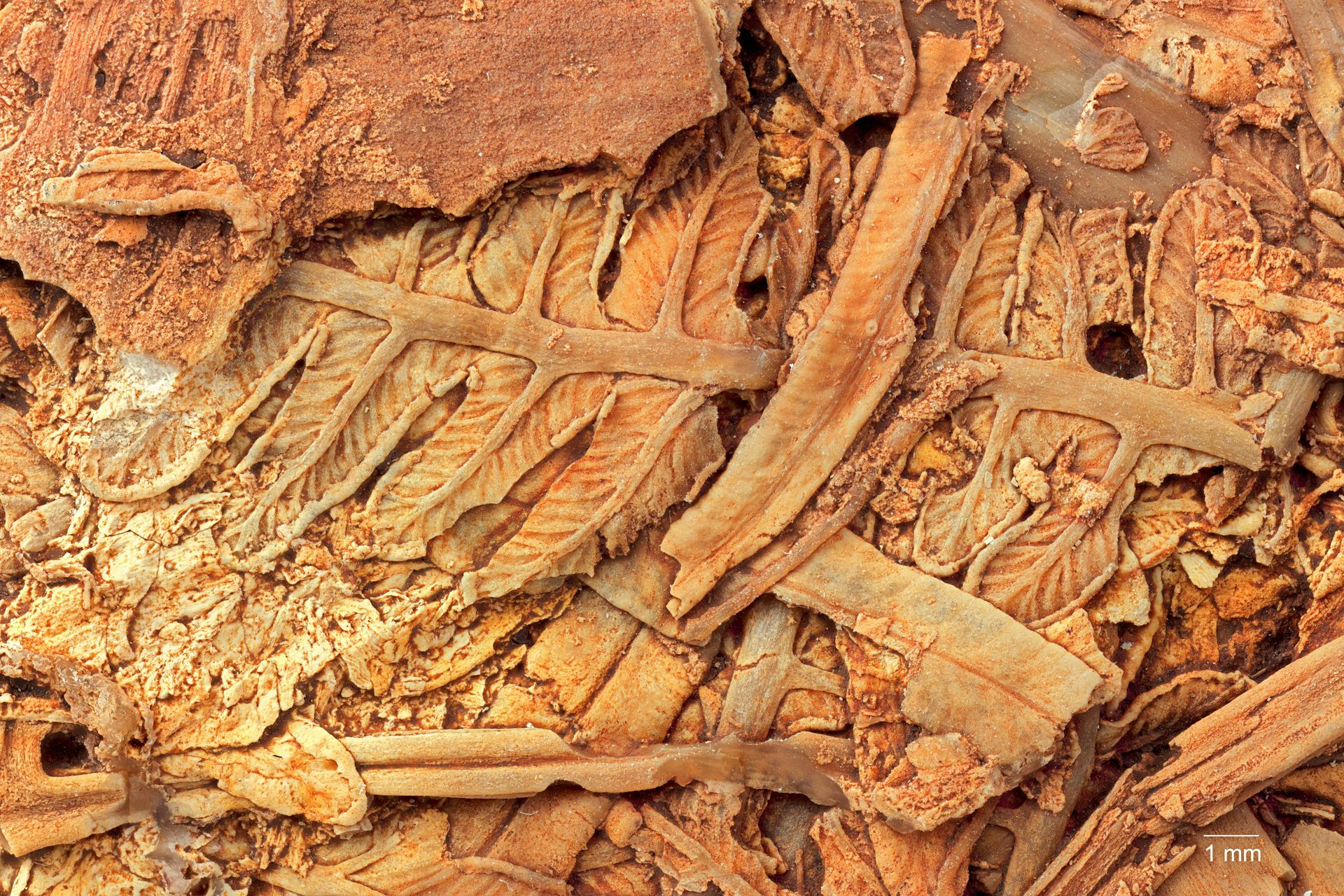
The foliage of a Pteridium fern, preserved in silcrete in exceptional detail.
Geoff Thompson/Queensland Museum
The process where silica infills and preserves plant structures is referred to as “silicification” or “permineralisation”. When plant material is buried, it provides acidic conditions that are ideal for this to happen.
And the process need not take millions of years. Overseas studies of plants in hot springs or undertaken in the laboratory have shown that some types of silica will quickly infiltrate wood and plant tissues.
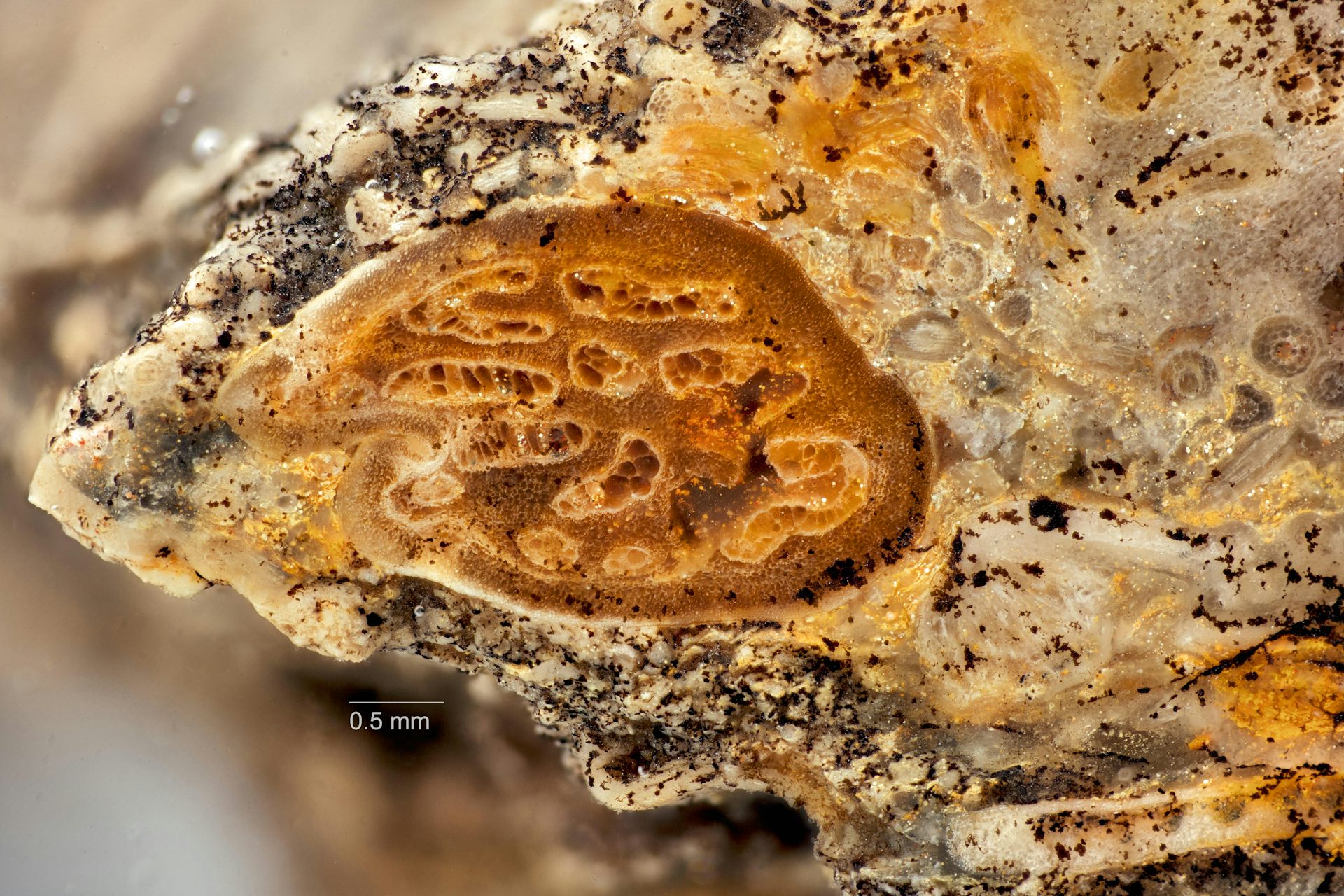
This is a cross-section of the stem (rhizome) of a silicified fern, showing its characteristic anatomy.
Geoff Thompson/Queensland Museum
Because of their rapid entombment by the volcanoes, we can be sure the plants were in situ (that is, their original location) and were actively growing. This means we can gain detailed information about the make-up of these past plant communities.
In other areas where plant fossils might accumulate – such as river deltas – we can never be sure how far the bits of plants were carried, and whether they were from different types of vegetation.
Silicification not only preserves plants, but also leaf litter on the forest floor and even the underlying soil containing roots and root nodules. The fossil plants that are preserved at different sites varies, indicating the presence of distinct plant communities.
The abundance of seeds and fruits at one site near Capella, in central Queensland, even indicated to us that the local volcanic eruptions are likely to have occurred in summer or early autumn during the fruiting season.

This cross-section of a silicified native grape seed shows its complex internal structure which is typical of the seeds of this family.
Geoff Thompson/Queensland Museum
The ferns include fronds and underground stems (rhizomes) of the familiar bracken fern (Pteridium). We have also found the distinctive seeds and lianas of the grape family (Vitaceae), along with evidence of insect damage in the wood. Two sites also had evidence of palms.
While there have been few previous studies on silcrete plants, we have revealed new insights into the history of the modern Australian flora.
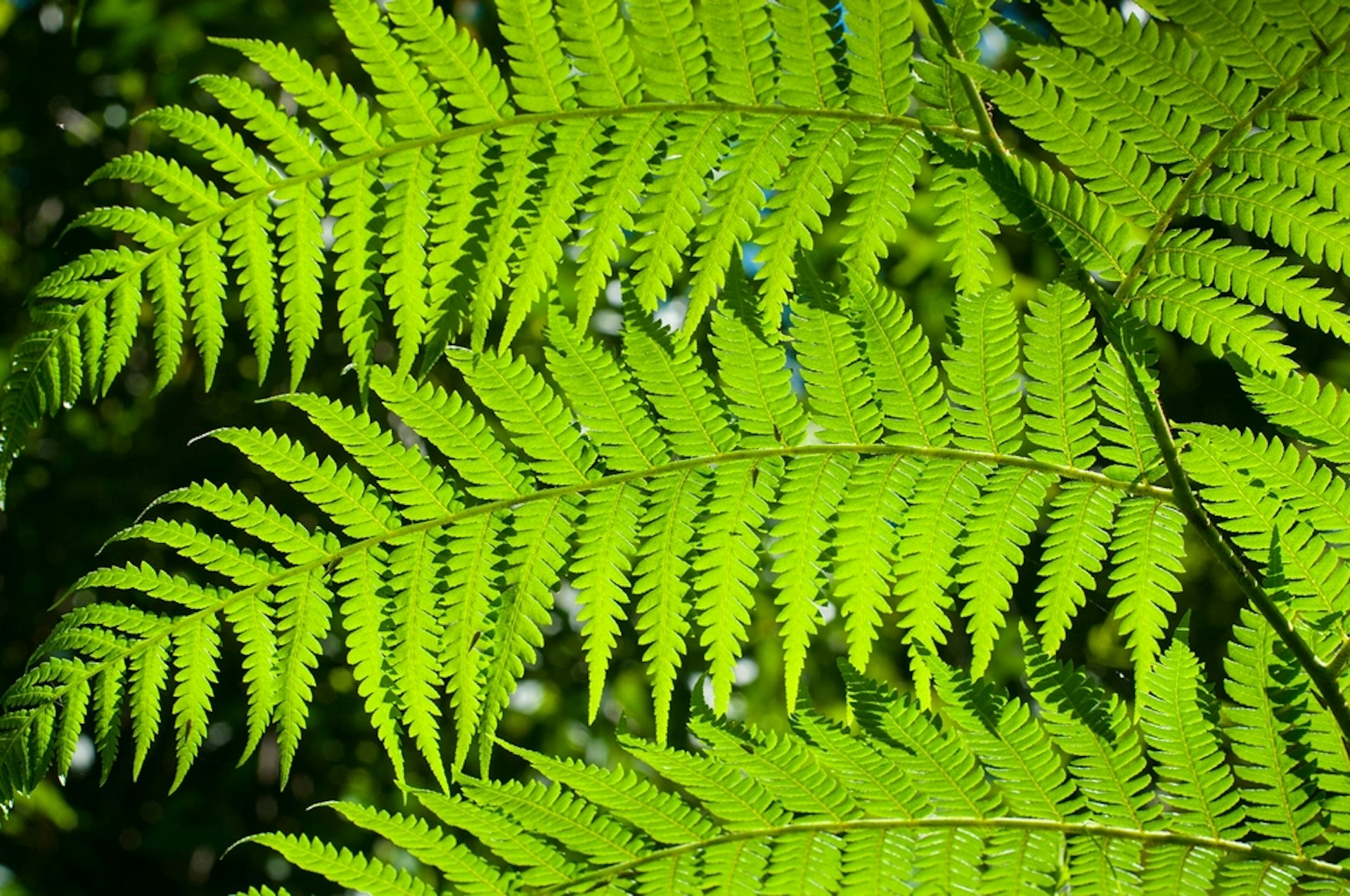
A modern bracken fern found in Queensland – the clear successor of the ferns found in the silcrete rocks.
Volcanic activity both destroys and modifies existing plant communities. It also provides new substrates for plants to colonise.
Several sites contained ferns – this may be because they are among the first living plants to colonise new volcanic terrains via their tiny wind-borne spores. For instance, it has been documented that bracken ferns were pioneer plants of the barren cone of the famous Krakatoa volcano after its eruption in 1883.
But the diversity of seeds and fruits at another site suggests that an existing forest was buried by volcanic activity.
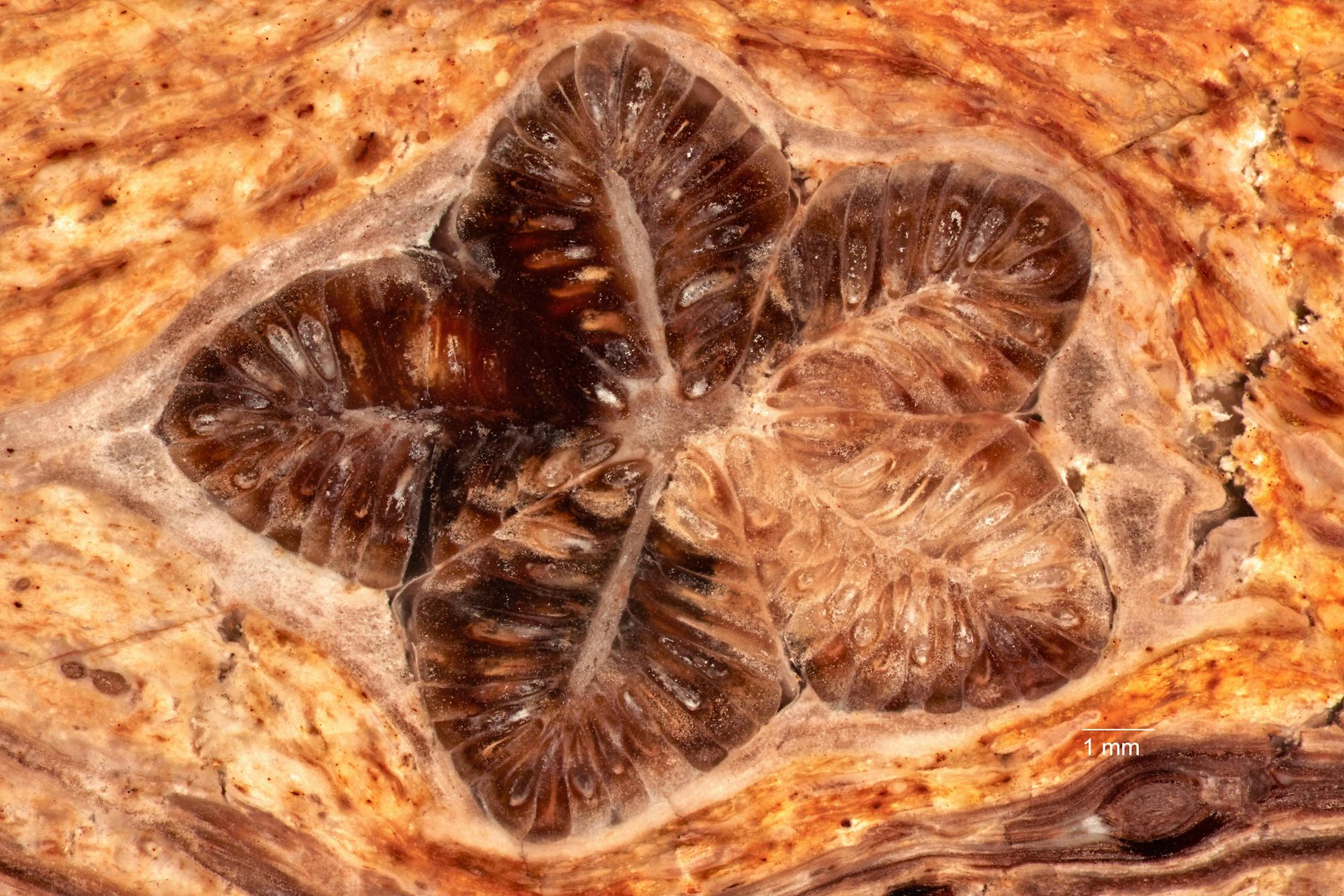
This star-shaped fruit, seen in cross section here, is currently being studied and is likely to be a species new to science.
Geoff Thompson/Queensland Museum
But the broad-scale volcano activity that occurred in eastern Australia during the Cenozoic has rarely been invoked as a key driver of such changes.
So remarkably preserved, the silcrete plant fossils are now providing startling new insights into the history of some groups of Australian plants and the vegetation types in which they grew.
The author would like to acknowledge co-author Raymond Carpenter from the University of Adelaide who contributed to this article.
Andrew Rozefelds, Adjunct Assoc Professor Central Queensland University and Principal Curator Geosciences Queensland Museum, CQUniversity Australia
This article is republished from The Conversation under a Creative Commons license. Read the original article.
AbstractI'd love to see creationists try to explain these findings from 30 million years before their mythical 'Creation Week' without resorting to the traditional lies about the scientists and their dating method or the usual childish conspiracy theory involving millions of biomedical scientists, their technical staff, the publishers of the science journals and their office staff, etc.
Fossil plants in sub-basaltic and fluvial silcretes differ in their geological setting, silica source, taphonomy, preservation and the plants and communities represented: these factors collectively indicate distinct silicification pathways. This review shows that the floras in sub-basaltic silcretes are mostly autochthonous, being derived from the local vegetation, whereas the floras in inland fluvial silcretes are transported and allochthonous. The floras in both are three-dimensionally preserved. The plants in sub-basaltic silcretes are usually permineralised, preserving internal anatomy and cellular morphology, whereas the plants in inland fluvial silcretes occur as moulds/impressions that may preserve epidermal and surface features. Both types of silcrete floras offer insights into past environments and ecological drivers. Terrestrial (ground-dwelling) ferns are frequently preserved in situ in sub-basaltic silcretes whilst in the inland fluvial silcretes they are represented only by pinnule fragments or abscised pinnules. The extraordinary anatomical preservation of soft tissues in sub-basaltic silcretes, e.g., exocarps of fruits, bark on wood, actively growing vegetative shoots (fern croziers) and root nodules, is evidence of rapid burial by volcanogenic sediments and subsequent silicification by silica-rich groundwaters. The source of silica was hydrothermal fluids released at the time of eruption and/or the weathering of overlying volcanics, and the acidic (humic) conditions resulting from buried plant material provided ideal geochemical conditions for silica precipitation and plant permineralisation. The sub-basaltic silcrete floras formed contemporaneously with Eocene–Miocene volcanism in eastern Australia, whereas the formation of inland pedogenic and fluvial silcretes was probably initiated during the Paleocene–Eocene Thermal Maximum (PETM). The fine surface preservation of plants in inland fluvial silcrete floras indicates rapid burial but no organic material is preserved, probably because oxidising groundwaters stripped out the organics before silicification occurred. The comparatively less silica-rich groundwaters associated with fluvial silcretes and the sandy substrates would have further contributed to the loss of plant material.
1. Introduction
Silcretes form through near-surface low-temperature silicification of unconsolidated sediments, weathered bedrock or soils (regolith), forming a brittle, very strongly indurated rock containing at least 85 % SiO2 (by weight) (Milnes and Twidale, 1983, Ullyott et al., 1998, Webb et al., 2013, Ullyott and Nash, 2016, Taylor and Eggleton, 2017). Silcretes are a type of duricrust, a lithified surface or near-surface layer impregnated by mineral precipitates, which include calcite (calcrete) and iron oxides and hydroxides (ferricrete) as well as silica. The silica input fills the original porosity as a cement composed of opal (opal-A, opal-C and opal-CT), chalcedony (fibrous quartz) or crystalline euhedral quartz, and/or replaces the original clays to form a matrix of quartz (Thiry et al., 2014, Gutiérrez-Castorena, M. del, 2018). The type of silica phase that forms is related to the geochemistry (Thiry et al., 2014): solutions with high silica content favour precipitation of amorphous whereas dilute solutions result in more crystalline phases (Lee, 2007). These precipitated silica phases differ in their solubility and structural order from disordered and relatively soluble (opal) to well-ordered with very low solubility at normal pH (euhedral quartz). The microcrystalline silica matrix in many silcretes contains cream to pale yellow streaks of very fine-grained titanium oxide (anatase) and/or small amounts of red to orange iron oxides (Webb et al., 2013, Eggleton and Taylor, 2017.1).
The study of silcrete has largely focused on occurrence, morphology, petrography and mineralogy to understand its origin, and has recognised two groups: pedogenic and non-pedogenic (Milnes and Twidale, 1983, Ullyott et al., 1998, Taylor and Eggleton, 2017). Pedogenic silcretes contain characteristic nodular, columnar, and/or massive layers that are the product of precipitation within the soil profile and have irregular bases that merge with the underlying sediments (Milnes and Twidale, 1983, Milnes et al., 1991, Thiry et al., 1988, Thiry et al., 1999, Taylor and Eggleton, 2017, Gutiérrez-Castorena, M. del, 2018 for additional references). These silcretes occur on a range of geological substrates and are conspicuous features of the landscape of inland Australia due to their resistance to weathering, frequently outcropping as low cliff lines 0.5–2 m high that can extend for hundreds of metres or even kilometres around the edges of mesas or cuestas (Milnes and Twidale, 1983, Fig. 1). Obtaining absolute dates from the pedogenic silcretes of inland Australia has proven difficult, because Miocene K-Ar dates obtained from alunite-group minerals and K-Mn oxides provide only minimum ages’, as these minerals are late-stage weathering products and fillings in dehydration cracks in the silcretes (Bird et al., 1990, Vasconcelos, 1996). As a result, there is an ongoing discussion regarding the timing of silicification, e.g., Callen, 1983.1, Callen, 2020.
Non-pedogenic silcretes lack features characteristic of soil profiles such as nodules and columns, and are typically massive in appearance, with sharp upper and lower boundaries. They generally occur topographically lower in the landscape than pedogenic silcretes and probably reflect silicification at the water table (Thiry and Milnes, 1991.1); for this reason they are often referred to as groundwater silcretes. Non-pedogenic silcretes can occur in different geomorphological settings, most commonly fluvial or lacustrine (Ullyott and Nash, 2016). Fluvial silcretes in inland Australia are often silicified quartz sands within paleochannels; these ‘drainage-line’ silcretes sit high in the contemporary landscape because their resistance to weathering has resulted in relief inversion (Webb and Golding, 1998.1, Greenwood et al., 1990.1, Alley, 1998.2, Alley et al., 1999.1, fig. 13; Taylor and Eggleton, 2017, Callen, 2020, Carpenter et al., 2014.1). The inland paleodrainage lines in which these fluvial silcretes have formed grade downstream into low energy lacustrine systems due to flat terrain and relatively low relief. Silicification of fine-grained lake sediments forms pan and lacustrine silcretes (Ullyott and Nash, 2016).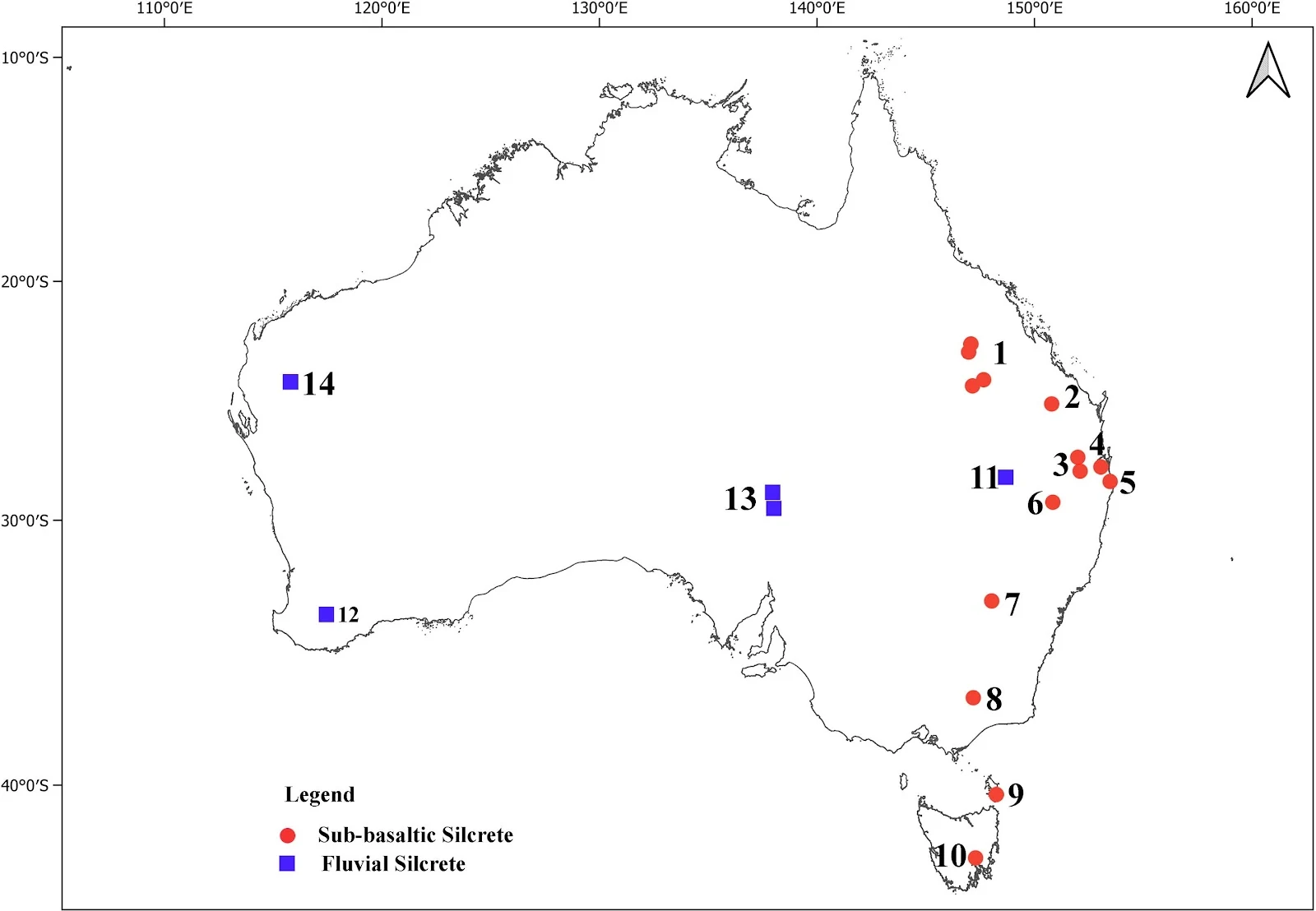 Fig. 1. Map of Australia showing the main fluvial and sub-basaltic silcrete floras in Australia and their age and volcanic province. 1. Capella sites, late Eocene–early Miocene, Clermont Province and Marmadilla and Springsure localities, Oligocene–early Miocene Springsure Province; 2. Blue Hills localities, Oligocene–early Miocene, Monto Province; 3. Late Oligocene–early Miocene, Bunya Mountains and Main Range Provinces; 4. Redbank Plains, Eocene, Brisbane Province; 5. Monaltrie, early Miocene, Lamington Province; 6. Delungra, Oligocene–early Miocene, Delungra Province; 7. Dalton fluvial channel, early Miocene, Grabben Gullen Province; 8. Jungle Creek, Eocene–Oligocene, Gelantipy Province; 9. Lady Barron, localised unnamed volcanics; 10. Macquarie Plains, localised unnamed volcanics; 11. Lightning Ridge fluvial channels; 12. Walebing-Kojonup fluvial channels; 13. Stuart Creek and Poole Creek fluvial channels; 14. Kennedy Range fluvial sediments. (For interpretation of the references to color in this figure legend, the reader is referred to the web version of this article.)
Fig. 1. Map of Australia showing the main fluvial and sub-basaltic silcrete floras in Australia and their age and volcanic province. 1. Capella sites, late Eocene–early Miocene, Clermont Province and Marmadilla and Springsure localities, Oligocene–early Miocene Springsure Province; 2. Blue Hills localities, Oligocene–early Miocene, Monto Province; 3. Late Oligocene–early Miocene, Bunya Mountains and Main Range Provinces; 4. Redbank Plains, Eocene, Brisbane Province; 5. Monaltrie, early Miocene, Lamington Province; 6. Delungra, Oligocene–early Miocene, Delungra Province; 7. Dalton fluvial channel, early Miocene, Grabben Gullen Province; 8. Jungle Creek, Eocene–Oligocene, Gelantipy Province; 9. Lady Barron, localised unnamed volcanics; 10. Macquarie Plains, localised unnamed volcanics; 11. Lightning Ridge fluvial channels; 12. Walebing-Kojonup fluvial channels; 13. Stuart Creek and Poole Creek fluvial channels; 14. Kennedy Range fluvial sediments. (For interpretation of the references to color in this figure legend, the reader is referred to the web version of this article.)
Non-pedogenic silcretes in eastern Australia often have a close geospatial connection with Cenozoic basalts that were erupted during intraplate volcanism (Johnson et al., 2009, Mather et al., 2020.1), and many studies have suggested a genetic link between them (Webb and Golding, 1998.1 and references therein). These silcretes crop out directly beneath or at most a few hundred metres away from basalt outcrops and are commonly known as sub-basaltic silcretes (Langford-Smith, 1978). These outcrops are typically semi-continuous layers of limited extent (<1 ha) and may break up into isolated fragments within the basaltic soil, so they are not significant features in the landscape and are easily overlooked during regional geological mapping. The material silicified includes weathered bedrock, soil and fluvial sediments.
Both the non-pedogenic inland fluvial silcretes and sub-basaltic silcretes occasionally contain fossil plants; in the latter these may be superbly preserved within an opaline silica or microcrystalline quartz matrix. Their fine preservation has attracted the attention of lapidary enthusiasts, and some sites, e.g., Macquarie Plains, Tasmania, have been heavily collected (Jordan and Hill, 2002); fortunately, material from other sites has been made available by collectors, thus providing an invaluable resource for both the current project and future studies. Paleobotanical studies of these silcrete floras have to date been descriptive in nature, focusing largely on the plant groups represented. However, these floras have the potential to contribute to an understanding of silcrete origins through providing information on the silicification of plant tissue, which is a complex multistage and multistate process involving different silica phases (Gee and Liesegang, 2021, Liesegang et al., 2021.1). In this paper we document and compare plant remains found in sub-basaltic and inland fluvial silcretes (Supplementary Table), focussing on their geological setting, mode of preservation and the organs and plant groups represented, in order to provide insights into past plant communities, paleoenvironment and silicification pathways. We review previous phytogeographical interpretations derived from some sub-basaltic and inland fluvial silcrete floras and discuss the significance of these floras for understanding the evolution of the modern Australian vegetation.
 Fig. 2. A. Permineralised dicotyledonous leaves (QMF 61184) in a leaf litter layer from QML 1775, Glencoe sub-basaltic silcrete, Capella District (Clermont Volcanic Province). The leaf shows raised primary and secondary venation indicating that this is abaxial leaf surface and a partially skeletonised leaf of the same species lies across the distal end of the leaf. B. Impression of lobed Proteaceae leaf (SAM P59649) from the Stuart Creek fluvial silcrete, South Australia. C. Impression of fragment of palmate dicot leaf from Stuart Creek that is comparable to Brachychiton Schott & Endl. (Sterculiaceae). (SAM P59650). D. Permineralised seeds of Liversidgea oxyspora F.Muell. (NHMUK V 26997) from sub-basaltic silcretes in the Lismore area, New South Wales (Lamington Volcanic Province). The six black seeds have well-preserved seed coats, and an aril (arrowed) is still in place in one seed. E. Synchrotron image showing the vascular structure and ovule arrangement in Spondylostrobus rozefeldsii Dettmann & Clifford (?Anacardiaceae) (QMF 68645) from Glencoe. F. Mould of an unidentified fossil fruit from Stuart Creek (SAM P59809). G. Photomontage of transverse, slightly oblique, section of a permineralised native grape seed (Vitaceae) (QMF 61185a), from a Main Range sub-basaltic silcrete. H. Impression of unidentified fruit (AM F 137082) from Lightning Ridge fluvial silcretes, New South Wales. I. Impression of winged ?Proteaceae seed (SAM P59810) from Stuart Creek, South Australia. J. Photo montage of permineralised fossil fruit, Fontainocarpa foraminata Rozefelds (Euphorbiaceae) (QMF 58787) from Glencoe showing the seeds, seed coat and vascular tissue. K. Photo montage photo of impression of seed of Manchesteria australis Stull & Rozefelds (Icacinaceae) (GSSA 6438 RS197/A), from Poole Creek fluvial silcrete, South Australia. The finely ‘pitted’ appearance of the seed is due to refraction of light around individual sand grains. L. Photomontage of cross section of a permineralised liana of Austrovideira dettmannae M.R.Pace & Rozefelds (Vitaceae) (QMF 58800) from Glencoe, showing the wood and bark (arrowed). M. Mould of a decorticated Proteaceae or Casuarinaceae stem (SAM P 59811), from Stuart Creek, South Australia showing the impression of rays. The internal wood has decomposed leaving a void, and sediments with leaves (arrowed), at a later stage, have infilled the void.Photographers: A. Rozefelds, Fig. 2A, B, D, I, M; R.S. Hill, Fig. 2C; A. Milroy, Fig. 2E; G. Thompson, Fig. 2G, J-L: M−A. Binnie, Fig. 2F; M. Goodwin, Fig. 2H.
Fig. 2. A. Permineralised dicotyledonous leaves (QMF 61184) in a leaf litter layer from QML 1775, Glencoe sub-basaltic silcrete, Capella District (Clermont Volcanic Province). The leaf shows raised primary and secondary venation indicating that this is abaxial leaf surface and a partially skeletonised leaf of the same species lies across the distal end of the leaf. B. Impression of lobed Proteaceae leaf (SAM P59649) from the Stuart Creek fluvial silcrete, South Australia. C. Impression of fragment of palmate dicot leaf from Stuart Creek that is comparable to Brachychiton Schott & Endl. (Sterculiaceae). (SAM P59650). D. Permineralised seeds of Liversidgea oxyspora F.Muell. (NHMUK V 26997) from sub-basaltic silcretes in the Lismore area, New South Wales (Lamington Volcanic Province). The six black seeds have well-preserved seed coats, and an aril (arrowed) is still in place in one seed. E. Synchrotron image showing the vascular structure and ovule arrangement in Spondylostrobus rozefeldsii Dettmann & Clifford (?Anacardiaceae) (QMF 68645) from Glencoe. F. Mould of an unidentified fossil fruit from Stuart Creek (SAM P59809). G. Photomontage of transverse, slightly oblique, section of a permineralised native grape seed (Vitaceae) (QMF 61185a), from a Main Range sub-basaltic silcrete. H. Impression of unidentified fruit (AM F 137082) from Lightning Ridge fluvial silcretes, New South Wales. I. Impression of winged ?Proteaceae seed (SAM P59810) from Stuart Creek, South Australia. J. Photo montage of permineralised fossil fruit, Fontainocarpa foraminata Rozefelds (Euphorbiaceae) (QMF 58787) from Glencoe showing the seeds, seed coat and vascular tissue. K. Photo montage photo of impression of seed of Manchesteria australis Stull & Rozefelds (Icacinaceae) (GSSA 6438 RS197/A), from Poole Creek fluvial silcrete, South Australia. The finely ‘pitted’ appearance of the seed is due to refraction of light around individual sand grains. L. Photomontage of cross section of a permineralised liana of Austrovideira dettmannae M.R.Pace & Rozefelds (Vitaceae) (QMF 58800) from Glencoe, showing the wood and bark (arrowed). M. Mould of a decorticated Proteaceae or Casuarinaceae stem (SAM P 59811), from Stuart Creek, South Australia showing the impression of rays. The internal wood has decomposed leaving a void, and sediments with leaves (arrowed), at a later stage, have infilled the void.Photographers: A. Rozefelds, Fig. 2A, B, D, I, M; R.S. Hill, Fig. 2C; A. Milroy, Fig. 2E; G. Thompson, Fig. 2G, J-L: M−A. Binnie, Fig. 2F; M. Goodwin, Fig. 2H.
Scale Bar: 1 cm in A, B, C, F, H, I, K, L; 1 mm in D; 5 mm in E, J, K, L; 0.05 mm in G.
 Fig. 4. Paleosols, roots and root nodules from sub-basaltic silcretes. A. Large roots (QMF 61181) from Monto (Monto Volcanic Province) preserved in silcrete at QML 214/QML 1770. B. Large roots (QMF 61182) preserved in silcrete at Glencoe, (Clermont Volcanic Province). C. Fine network of roots (QMF 61183) preserved in Glencoe silcrete (QML1775). D-E. Root nodules associated with probable podocarp conifer roots, preserved in silcretes at Glencoe, D. QMF 61191, E. QMF 54813. F-G. Palm stem (QMF 61186) from Monto showing a lower section of the bole base surrounded by a large mass of adventitious roots indicating the stem was preserved in situ.Photographer A. Rozefelds.
Fig. 4. Paleosols, roots and root nodules from sub-basaltic silcretes. A. Large roots (QMF 61181) from Monto (Monto Volcanic Province) preserved in silcrete at QML 214/QML 1770. B. Large roots (QMF 61182) preserved in silcrete at Glencoe, (Clermont Volcanic Province). C. Fine network of roots (QMF 61183) preserved in Glencoe silcrete (QML1775). D-E. Root nodules associated with probable podocarp conifer roots, preserved in silcretes at Glencoe, D. QMF 61191, E. QMF 54813. F-G. Palm stem (QMF 61186) from Monto showing a lower section of the bole base surrounded by a large mass of adventitious roots indicating the stem was preserved in situ.Photographer A. Rozefelds.
Scale bar: 1.0 cm in A, B, C, G; 5 mm in D, E; 2.5 cm in F.
 Fig. 5. Permineralised fern foliage associated with sub-basaltic silcretes. A. Fern foliage showing the abaxial pinna surface and venation within each pinnule from Glencoe, Queensland (Clermont Volcanic Province). (QM F61187). B. Fern foliage from Monaltrie, New South Wales, (Lamington Volcanic Province). The recurved margins, veins bifurcating once near their base and extending to the margin, and free lobes on the rachis (arrowed) indicate affinities to Pteridium Gled. ex Scop. (NHMUK V 26999). C. Fern foliage tentatively referred to Pteridium (QMF 61193) from Delungra, NSW (Delungra Volcanic Province), showing recurved margins and veins bifurcating near their base. D. Fern foliage (QMF 61194) from Pimpimbudgee Road near Kingaroy, Queensland (Bunya Mountains Volcanic Province) showing pinnule venation consistent with Pteridium. E. Fern foliage (QMF 61190) from Glencoe. F. Unidentified fern crozier (QMF 61188) from Glencoe; the aerophore (arrowed) is evident as a curved linear structure on the crozier. G. Fern foliage (QMF 61192) from Glencoe showing anastomosing venation (arrowed) between pinnules, which suggests affinities to the Thelypteridaceae.Photographer A. Rozefelds.
Fig. 5. Permineralised fern foliage associated with sub-basaltic silcretes. A. Fern foliage showing the abaxial pinna surface and venation within each pinnule from Glencoe, Queensland (Clermont Volcanic Province). (QM F61187). B. Fern foliage from Monaltrie, New South Wales, (Lamington Volcanic Province). The recurved margins, veins bifurcating once near their base and extending to the margin, and free lobes on the rachis (arrowed) indicate affinities to Pteridium Gled. ex Scop. (NHMUK V 26999). C. Fern foliage tentatively referred to Pteridium (QMF 61193) from Delungra, NSW (Delungra Volcanic Province), showing recurved margins and veins bifurcating near their base. D. Fern foliage (QMF 61194) from Pimpimbudgee Road near Kingaroy, Queensland (Bunya Mountains Volcanic Province) showing pinnule venation consistent with Pteridium. E. Fern foliage (QMF 61190) from Glencoe. F. Unidentified fern crozier (QMF 61188) from Glencoe; the aerophore (arrowed) is evident as a curved linear structure on the crozier. G. Fern foliage (QMF 61192) from Glencoe showing anastomosing venation (arrowed) between pinnules, which suggests affinities to the Thelypteridaceae.Photographer A. Rozefelds.
Scale bar: 5 mm in A, F; 1 cm in B, C- E, G.
Rozefelds, Andrew C.; ; Webb, John; Carpenter, Raymond J.; Milroy, Anita K.; Hill, Robert S.
Born of fire, borne by water – Review of paleo-environmental conditions, floristic assemblages and modes of preservation as evidence of distinct silicification pathways for silcrete floras in Australia
Gondwana Research, 130 234-249; DOI: 10.1016/j.gr.2024.02.001
Copyright: © 2024 The authors.
Published by Elsevier B.V. Open access
Reprinted under a Creative Commons Attribution 4.0 International license (CC BY 4.0)
For the record, the association of these fossil-bearing formations with volcanos means U-Pb dating of zircons was almost certainly the basis for the dating of the rocks these fossils were embedded in.
Ten Reasons To Lose Faith: And Why You Are Better Off Without It
This book explains why faith is a fallacy and serves no useful purpose other than providing an excuse for pretending to know things that are unknown. It also explains how losing faith liberates former sufferers from fear, delusion and the control of others, freeing them to see the world in a different light, to recognise the injustices that religions cause and to accept people for who they are, not which group they happened to be born in. A society based on atheist, Humanist principles would be a less divided, more inclusive, more peaceful society and one more appreciative of the one opportunity that life gives us to enjoy and wonder at the world we live in.
Available in Hardcover, Paperback or ebook for Kindle
What Makes You So Special? From The Big Bang To You
How did you come to be here, now? This books takes you from the Big Bang to the evolution of modern humans and the history of human cultures, showing that science is an adventure of discovery and a source of limitless wonder, giving us richer and more rewarding appreciation of the phenomenal privilege of merely being alive and able to begin to understand it all.
Available in Hardcover, Paperback or ebook for Kindle






No comments :
Post a Comment
Obscene, threatening or obnoxious messages, preaching, abuse and spam will be removed, as will anything by known Internet trolls and stalkers, by known sock-puppet accounts and anything not connected with the post,
A claim made without evidence can be dismissed without evidence. Remember: your opinion is not an established fact unless corroborated.